Information System and Technology Optimization as a Tool for Ensuring the Competitiveness of a Railway Undertaking—Case Study
Abstract
1. Introduction
2. Background
- Minimizing of workload,
- Maximizing the financial reward for the work performed [8].
Compilation of Shifts and Shifplans of Operational Employees in Information System KASO
3. Results
- Locomotive driver,
- Accompanying staff,
- Passenger wagons,
- Locomotive.
3.1. Design of Methodology for Automatic Creating of Circulation and Shiftplans
3.2. Draft Recommendations and Measures for the Carrier
- Define the partial elements that will be rationalized—that is, to create circulations and shifplans along defined and logical parts, such as according to railway lines, transport routes, or regions. It is not appropriate to create circuits and shifts in such a way that we will consider only a limited number of selected trains from different lines. Such a solution will not be optimal from a complex point of view. It is, therefore, always necessary to insert all trains there according to the above proposals (lines, routes, regions).
- It is necessary to deploy only one type of railway vehicle (staff) on a defined element (lines, routes, regions). For example, on the selected line, locomotive of the same series should be deployed on all trains, not to combine them with each other. To increase the transport capacity in specific trains, it is necessary to add another locomotive but again of the same type. This solution is also suitable in terms of quality from the point of view of passengers, who will always know that only a given type of locomotive with the given parameters operates on a given route.
- From a technological point of view, it is much more advantageous to use complete units or return ones (push-pull) and with conventional sets (locomotive + wagons) it is advisable to use a control wagon at the end of this set so that the locomotive does not overflow when changing train direction, which has a negative impact on technological times. Thanks to this, the costs associated with the shift are also saved.
- Make circulations and shifts separately for each time and date limit. At the same time, try to reduce the number of these restrictions to avoid confusion. For example, it would be appropriate to have restrictions only on working days and weekends, with circulations and shifts being prepared separately for working days and weekends according to the timetable. It is ideal to run as many trains as possible without restrictions (daily).
- Last but not least, it is necessary to predispose quality circulations of railway vehicles to ensuring their quality maintenance in order to prevent failures. In the case of shifts of operational employees, it is necessary to positively motivate these employees to perform their service and give them an adequate salary for this performance.
Recommendations Concerning Train Staff
4. Discussion
Author Contributions
Funding
Conflicts of Interest
References
- Iwnicki, S. Handbook of Railway Vehicle Dynamics; CRC Press: Boca Raton, FL, USA, 2006. [Google Scholar]
- Abramovic, B.; Pasagic, S.J.; Sipus, D. Analysis of Railway Infrastructure Charges Fees on the Local Passengers’ Lines in Croatia. In Proceedings of the 3rd International Conference of Traffic and Transport Engineering ICTTE, Belgrade, Serbia, 24–25 November 2016; pp. 918–923. [Google Scholar]
- Song, Y.; Liu, Z.; Rxnnquist, A.; Navik, P.; Liu, Z. Contact wire irregularity stochastics and effect on high-speed railway pantograph–catenary interactions. IEEE Trans. Instrum. Meas. 2020, 69, 8196–8206. [Google Scholar] [CrossRef]
- Wang, Z.; Song, Y.; Yin, Z.; Wang, R.; Zhang, W. Random response analysis of axle-box bearing of a high-speed train excited by crosswinds and track irregularities. IEEE Trans. Veh. Technol. 2019, 68, 10607–10617. [Google Scholar] [CrossRef]
- Chen, M.; Chen, Y.; Wei, M. Modeling and control of a novel hybrid power quality compensation system for 25-kV electrified railway. Energies 2019, 12, 3303. [Google Scholar] [CrossRef]
- Derek, J.C.; Terje, A.M. Salience in a simple transport market. Res. Transp. Econ. 2020, 82. [Google Scholar] [CrossRef]
- Bussieck, M.R.; Winter, T.; Zimmermann, U.T. Discrete optimization in public rail transport. Math. Program. 1997, 79, 415–444. [Google Scholar] [CrossRef]
- Caprara, A.; Kroon, L.; Monaci, M.; Peeters, M.; Toth, P. Passenger railway optimization. Transportation 2007, 14, 129–187. [Google Scholar] [CrossRef]
- Camaj, J.; Nedeliakova, E.; Hranicky, M.P.; Dolinayova, A.; Kendra, M. Project 0460/2019 Analytical Study—Basis for Elaboration of Methodology for Processing Train Essentials; University of Žilina, Railway Carrier ZSSK: Žilina, Slovakia, 2019. [Google Scholar]
- Yang, A.A.; Wang, B.; Huang, J.L.; Li, C. Service replanning in urban rail transit networks: Cross-line express trains for reducing the number of passenger transfers and travel time. Transp. Res. Part C Emerg. Technol. 2020, 115. [Google Scholar] [CrossRef]
- Kostkova, M.; Pellesova, P. The Influence of Globalization on the Offer of Passenger Rail Transport in The Czech Republic. In Proceedings of the 16th International Scientific Conference on Globalization and Its Socio-Economic Consequences, Rajecke Teplice, Slovakia, 5–6 October 2016; pp. 1005–1013. [Google Scholar]
- Altazin, E.; Dauzere-Peres, S.; Ramond, F.; Trefond, S. Rescheduling through stop-skipping in dense railway systems. Transp. Res. Part C Emerg. Technol. 2017, 79, 73–84. [Google Scholar] [CrossRef]
- Almodovar, M.; Garcia-Rodenas, R. On-line reschedule optimization for passenger railways in case of emergencies. Comput. Oper. Res. 2013, 40, 725–736. [Google Scholar] [CrossRef]
- Cacchiani, V.; Huisman, D.; Kidd, M.; Kroon, L.; Toth, P.; Veelenturf, L.; Wagenaar, J. An overview of recovery models and algorithms for real-time railway rescheduling. Transp. Res. Part B Methodol. 2014, 63, 15–37. [Google Scholar] [CrossRef]
- Abbink, E.J.W.; Albino, L.; Dollevoet, T. Solving large scale crew scheduling problems in practice. Public Transp. 2011, 3, 149–164. [Google Scholar] [CrossRef]
- Cacchiani, V.; Caprara, A.; Toth, P. Models and Algorithms for the Train Unit Assignment Problem. In Proceedings of the Second International Symposium, ISCO; Springer: Berlin/Heidelberg, Germany, 2012; pp. 24–35. [Google Scholar]
- Huisman, D.; Kroon, L.G.; Lentink, R.M. Operations Research in passenger railway transportation. Stat. Neerl. 2005, 59, 467–497. [Google Scholar] [CrossRef]
- Milinkovic, S.; Marton, P.; Mašek, J.; Nedeliakova, E.; Gasparik, J.; Kendra, M.; Camaj, J.; Izvolt, L.; Belosevic, I.; Pavlovic, N.; et al. Increasing of Effectivenes of the Railway Transport Services Using the Decision-Support Systems; APVV Project: Belgrade, Serbia, 2018. [Google Scholar]
- Guihery, L. Competition in regional passenger rail transport in Germany (Leipzig) and lessons to be drawn for France. Res. Transp. Econ. 2014, 48, 298–304. [Google Scholar] [CrossRef]
- Dolinayova, A. Possibilities to Quantify Fixed Costs for Long-Distance and Regional Railway Passenger Transport. In Proceedings of the International Conference on Traffic and Transport Engineering (ICTTE), Belgrade, Serbia, 27–28 September 2018; pp. 954–959. [Google Scholar]
- Cordeau, J.F.; Toth, P.; Vigo, D. A survey of optimization models for train routing and scheduling. Transp. Sci. 1998, 32, 380–404. [Google Scholar] [CrossRef]
- Stefancova, V.; Nedeliakova, E.; Lopez-Escolano, C. Connection of Dynamic Quality Modeling and Total Service Management in Railway Transport Operation. In Proceedings of the 12th International Scientific Conference of Young Scientists on Sustainable, Modern and Safe Transport, Procedia Engineering, High Tartas, Slovakia, 31 May–2 June 2017; pp. 834–839. [Google Scholar] [CrossRef]
- Nedeliakova, E.; Sekulova, J.; Nedeliak, I.; Majercak, P. Safety of Level Crossings from Society-Wide Perspective. In Proceedings of the 18th International Conference on Transport Means, Kaunas, Lithuania, 23–24 October 2014; pp. 326–328. [Google Scholar]
- Acuna-Agost, R.; Michelon, P.; Feillet, D. A MIP-based local search method for the railway rescheduling problem. Networks 2011, 57, 69–86. [Google Scholar] [CrossRef]
- Adenso-Díaz, B.; González, M.O.; González-Torre, P. On-line timetable re-scheduling in regional train services. Transp. Res. Part B Methodol. 1999, 33, 387–398. [Google Scholar] [CrossRef]
- Nedeliakova, E.; Stefancova, V.; Kuka, A. Innovative Methodology for Quality and Risk Management in Logistics Processes of Transport Undertakings. In Proceedings of the 18th International Scientific Conference on Business Logistics in Modern Management, Osijek, Croatia, 7–9 October 2018; pp. 41–53. [Google Scholar]
- Carey, M.; Lockwood, D. A model, algorithms and strategy for train pathing. J. Oper. Res. Soc. 1995, 46, 988–1005. [Google Scholar] [CrossRef]
- Caprara, A.; Fischetti, M.; Toth, P. Modeling and solving the train timetabling problem. Oper. Res. 2002, 50, 851–861. [Google Scholar] [CrossRef]
- Nedeliakova, E.; Cerna, L.; Bukova, B.; Dolinayova, A.; Camaj, J.; Masek, J.; Zitricky, V.; Klapita, V.; Majercak, J.; Madlenak, R.; et al. Project KEGA No. 014ŽU-4/2020. Six Sigma and Progressive Education of the Quality Management in the Railway Transport Field of Study in Accordance with the Requirements of Railway Undertakings; Ministry of Education, Science, Research and Sport of the Slovak Republic: Bratislava, Slovakia, 2020. [Google Scholar]
- Tang, H.; Dick, C.T.; Caughron, B.M.; Feng, X.; Wang, Q.; Barkan, C.P.L. Model for optimal selection of projects to improve running time and operating cost efficiency on passenger rail corridors. Transp. Res. Rec. 2016, 2546, 33–42. [Google Scholar] [CrossRef]
- Cacchiani, V.; Toth, P. Nominal and robust train timetabling problems. Eur. J. Oper. Res. 2012, 219, 727–737. [Google Scholar] [CrossRef]
- Buková, B.; Nedeliaková, E.; Gašparík, J. Podnikanie v Železničnej Doprave, 1st ed.; Iura Edition: Bratislava, Slovakia, 2009; p. 276. [Google Scholar]
- Gašparík, J.; Šulko, P. Technológia Železničnej Dopravy—Líniové Dopravné Procesy, 1st ed.; EDIS Žilinská Univerzita v Žiline: Žilina, Slovakia, 2015; p. 340. [Google Scholar]
- Gašparík, J.; Pečený, L. Grafikon Vlakovej Dopravy a Priepusnosť Sietí, 1st ed.; EDIS Žilinská Univerzita v Žiline: Žilina, Slovakia, 2009; p. 3258. [Google Scholar]
- Jarašūnienė, A.; Čižiūnienė, K.; Petraška, A. Research on rail and maritime transport interoperability in the area of information systems: The case of Lithuania. Transport 2019, 34, 467–475. [Google Scholar] [CrossRef]
- Yan, R.; Wu, C.; Wang, Y. Exploration and evaluation of individual difference to driving fatigue for high-speed railway: A parametric SVM model based on multidimensional visual cue. IET Intell. Transp. Syst. 2018, 12, 504–512. [Google Scholar] [CrossRef]
- Saianand, G.; Sonar, P.; Wilson, G.J.; Gopalan, A.-I.; Roy, V.A.; Unni, G.E.; Reza, K.M.; Bahrami, B.; Venkatramanan, K.; Qiao, Q. Current advancements on charge selective contact interfacial layers and electrodes in flexible hybrid perovskite photovoltaics. J. Energy Chem. 2021, 54, 151–173. [Google Scholar] [CrossRef]
- Wołek, M.; Wolański, M.; Bartłomiejczyk, M.; Wyszomirski, O.; Grzelec, K.; Hebel, K. Ensuring sustainable development of urban public transport: A case study of the trolleybus system in Gdynia and Sopot (Poland). J. Clean. Prod. 2021, 279, 123807. [Google Scholar] [CrossRef]
- Tveit, M.; Gjerde, K. Using Building Information Modelling for Planning a High-Speed Rail Project in Norway. In Proceedings of the Institution of Civil Engineers-Civil Engineering; Norway, 2018 ICE Publishing: London, UK, 2018; Volume 171. [Google Scholar] [CrossRef]
- Lin, B.; Wang, J.; Wang, H.; Wang, Z.; Li, J.; Lin, R.; Xiao, J.; Wu, J. Ordering cost with different ordering strategies in Shanghai EMU depot. Figshare 2017. [Google Scholar] [CrossRef]
- Atack, J. Historical Transportation of Navigable Rivers, Canals, and Railroads in the United States; ICPSR: Ann Arbor, MI, USA, 2016. [Google Scholar] [CrossRef]
- Leong, K.H.; Abdul-Rahman, H.; Wang, C.; Onn, C.C.; Loo, S.-C. Steps to identify the optimum route by using the algorithm. Figshare 2016. [Google Scholar] [CrossRef]
- Leong, K.H.; Abdul-Rahman, H.; Wang, C.; Onn, C.C.; Loo, S.-C. Bee inspired novel optimization algorithm and mathematical model for effective and efficient route planning in railway system. PLoS ONE 2016, 11, e0166064. [Google Scholar] [CrossRef]
- Mottaeva, A.; Mottaeva, A. Planning and Modeling of Urban Transport Infrastructure. In Proceedings of the International Scientific Conference on Energy Management of Municipal Facilities and Sustainable Energy Technologies, EMMFT, Voronezh, Russia, 28–30 November 2019. [Google Scholar]
- Zimny-Schmitt, D.; Goetz, A.R. An investigation of the performance of urban rail transit systems on the corridor level: A comparative analysis in the American west. J. Transp. Geogr. 2020, 88, 102848. [Google Scholar] [CrossRef]
- Liu, Y.; Cheng, T. Understanding public transit patterns with open geodemographics to facilitate public transport planning. Transp. A Transp. Sci. 2018, 16, 76–103. [Google Scholar] [CrossRef]
- Chernov, A.V.; Butakova, M.A.; Karpenko, E.V. Security Incident Detection Technique for Multilevel Intelligent Control Systems on Railway Transport in Russia. In Proceedings of the 23rd Telecommunications Forum (TELFOR), Belgrade, Serbia, 24–25 November 2015. [Google Scholar]
- Richardson, D. Transportation GIS Layers for the Eastern Shore of Virginia 2013; LTER Network Information System Repository; 2014; Available online: https://portal.edirepository.org/nis/mapbrowse?scope=knb-lter-vcr&identifier=226&revision=2 (accessed on 27 October 2020). [CrossRef]
- Lorenc, A.; Michnej, M.; Szkoda, M. An Information System Aiding the Processes of Cargo Loading and Securing in Railway Transport. In Proceedings of the Carpathian Logistics Congress (CLC), Cracow, Poland, 9–11 December 2013. [Google Scholar]
- Matulic, I.; Musa, M.; Perakovic, D. Information and Communication Infrastructure for the Organisation of Railway Passenger Transport. In Proceedings of the 2nd International Conference on Traffic and Transport Engineering (ICTTE), Belgrade, Serbia, 27–28 November 2014. [Google Scholar]
- Kultygin, O. Integrated information system for mashinists’ route sheets processing. J. Appl. Inform. 2014. Available online: http://www.appliedinformatics.ru/e/articles/index.php?article_id_4=1642 (accessed on 26 October 2020).
- Jäppinen, E.; Korpinen, O.-J.; Ranta, T. The effects of local biomass availability and possibilities for truck and train transportation on the greenhouse gas emissions of a small-diameter energy wood supply chain. BioEnergy Res. 2013, 6. [Google Scholar] [CrossRef]
- Ji, S.W.; Li, C.C. Railway passenger trains information inquiry system based on short message modem. Adv. Mater. Res. 2013, 675, 39–42. [Google Scholar] [CrossRef]
- Zharska, I.O. Information systems and technology in the marketing of railway transport. Mark. Manag. Innov. 2013, 1, 100–111. [Google Scholar]
- Kotenko, I.V.; Saenko, I.B.; Chernov, A.V.; Butakova, M.A. The construction of a multi-level intelligent information security system for automated systems of railway transport. SPIIRAS 2013, 7, 7. [Google Scholar] [CrossRef][Green Version]
- Gong, C.; Fan, W. A New Automatic. Train Identification System Based on RFID. Lecture Notes in Computer Science. In Proceedings of the 11th International Conference on Web Information Systems Engineering, Sydney, NSW, Australia, 12–14 October 2011; Volume 6724. [Google Scholar]
- Sukalova, V.; Ceniga, P. Critical Success Factors of the Road Transport Company. In Proceedings of the19th International Scientific Conference on Transport Means 2015, Kaunas University of Technology, Kaunas, Lithuania, 22–23 October 2015; pp. 708–711. [Google Scholar]
- Suchanek, A.; Loulova, M.; Harusinec, J. Evaluation of passenger riding comfort of a rail vehicle by means dynamic simulations. In Proceedings of the 23rd Polish-Slovak Scientific Conference on Machine Modelling and Simulations (MMS 2018), Rydzyna, Poland, 4–7 September 2018. [Google Scholar]
- Mikeš, P. Behavioural aspects in the optimalization of the transport system. Int. J. Syst. Sci. 1975, 6, 57–66. [Google Scholar] [CrossRef]
- Nedeliakova, E.; Hudakova, M.; Masar, M.; Lizbetinova, L.; Stasiak-Betlejewska, R.; Šulko, P. Sustainability of railway undertaking services with lean philosophy in risk management—Case study. Sustainability 2020, 12, 5298. [Google Scholar] [CrossRef]
- Abramovic, B. Liberalization of Railway Market as a Challenge for the National Operator; Glob Trends; Springer: Cham, Switzerland, 2012; pp. 12–18. [Google Scholar]
- Andrejszki, T.; Csete, M.; Torok, A. Identifying Modal Shift by Utility Functions to Reach an Optimal Point of Regional Development. In Proceedings of the 14th International Conference Reliability and Statistics in Transportation and Communication (RelStat’14), Riga, Latvia, 15–18 October 2014; pp. 15–18. [Google Scholar]
- Ližbetinová, L.; Štarchoň, P.; Weberová, D.; Nedeliaková, E.; Juříková, M. The approach of SMEs to using the customer databases and CRM: Empirical study in the Slovak Republic. Sustainability 2020, 12, 227. [Google Scholar] [CrossRef]
- Wolniak, R. Main functions of operation management. Prod. Eng. Arch. 2020, 26, 11–14. [Google Scholar] [CrossRef]
- Tsiktsiris, D.; Dimitriou, N.; Lalas, A.; Dasygenis, M.; Votis, K.; Tzovaras, D. Real-Time Abnormal Event Detection for Enhanced Security in Autonomous Shuttles Mobility Infrastructures. Sensors 2020, 4943. [Google Scholar] [CrossRef]
- Xu, Y. Characterizing destination networks through mobility traces of international tourists—A case study using a nationwide mobile positioning dataset. Tour. Manag. 2021, 81, 104195. [Google Scholar] [CrossRef]
- Jing, Y.; Si-Ye, G.; Wang, X.; Fang-Qiu, C. Research on Coordinated Development of a Railway Freight Collection and Distribution System Based on an “Entropy-TOPSIS Coupling Development Degree Model” Integrated with Machine Learning. J. Adv. Transp. 2020. [Google Scholar] [CrossRef]
- Avineri, E. A cumulative prospect theory approach to passengers’ behavior modeling: Waiting time paradox revisited. J. Intell. Transport. Syst. 2004, 8, 195–204. [Google Scholar] [CrossRef]
- Kour, R.; Karim, R.; Thaduri, A. Cybersecurity for railways—A maturity model. Proc. Inst. Mech. Eng. Part F J. Rail Rapid Transit 2020. [Google Scholar] [CrossRef]
- Orozco, M.F.U. Information design: A mediator between the oral tradition and the digital sphere in public transport. The Case of the Western Mass Integrated Transport System of Cali -MIO (for its initials in Spanish). Iconofacto 2014, 10, 51–75. [Google Scholar]
- Newmire, D.E.; Willoughby, D.S. Partial Range of Motion Resistance Training: A Feasible Bodybuilding Training Regiment for Local or Regional Muscle Hypertrophy. Strenght Cond. J. 2020, 5. [Google Scholar] [CrossRef]
- Stoilova, S. An Integrated Multi-Criteria Approach for Planning Railway Passenger Transport in the Case of Uncertainty. Symmetry 2020, 12, 949. [Google Scholar] [CrossRef]
- Bartnicka, J.; Kabiesz, P.; Kaźmierczak, J. Standardization of human activities as the component of a workflow efficiency model – a research experiment from a meat producing plant. Prod. Eng. Arch. 2020, 26, 73–77. [Google Scholar] [CrossRef]
- Yildirim, V.; Bediroglu, S. A geographic information system-based model for economical and eco-friendly high-speed railway route determination using analytic hierarchy process and least-cost-path analysis. Expert Syst. 2019, 36. [Google Scholar] [CrossRef]
- Wittenborn, A.; Cadez, I.; Schumann, R. Handling of information security in digitally supported construction projects—Part 1: Risk potentials in the application of the BIM methodology. Bautechnik 2020. [Google Scholar] [CrossRef]
- Jia, C.; Jia, C.; Xu, H.; Wang, L. A Robust nonlinear model predictive control for automatic train operation based on constraint tightening strategy. Asian J. Control 2020. [Google Scholar] [CrossRef]
- Van der Wees, B.J.; Moonen, J.M. The Potential of In-train Crowdsourcing. In Proceedings of the 24th Bled eConference eFuture: Creating Solutions for the Individual, Organisations and Society, Bled, Slovenia, 12–15 June 2011. [Google Scholar]
- Yang, J. A Study on the development of logistics information technology for revitalization of railway transports. 전자무역연구—Electron. Trade Res. 2009, 7, 125–151. [Google Scholar] [CrossRef]
- Johansson, N.; Roth, E.; Reim, W. Smart and Sustainable eMaintenance: Capabilities for Digitalization of Maintenance. Sustainability 2019, 11, 3553. [Google Scholar] [CrossRef]
- Teplý, B.; Vymazal, T.; Rovnaníková, P. Introduction to an approach to performing sustainability quantification of concrete structures. Solid State Phenomena 2018, 272, 273–279. [Google Scholar] [CrossRef]
- Beklaryan, L.A.; Khachatryan, N.K. Dynamic models of cargo flow organization on railway transport. Econ. Math. Methods 2019, 55, 62–73. [Google Scholar] [CrossRef]
- Office for National Statistics, Social and Vital Statistics Division. ONS Omnibus Survey, October 2006; UK Data Archive: Essex, UK, 2008; Volume 1. [Google Scholar] [CrossRef]
- Chin, S.-M.; Hwang, H.-L.; Peterson, B. Geospatial products and techniques at the center for transportation analysis. J. Map Geogr. Libr. 2008, 4. [Google Scholar] [CrossRef]
- Xu, J.; Cheng, X.; Zhou, H.; Jia, L. Model on Information Revising of Supervisory and Control Systems. In Proceedings of the 6th International Conference of Traffic and Transportation Studies Congress (ICTTS), Nanning, China, 5–7 August 2008. [Google Scholar]
- Xu, J.; Li, P.; Jia, L.M.; Xu, X.C. The Information Sharing Platform of Chinese RITS. In Proceedings of the Eastern Asia Society for Transportation Studies (EASTS), Bangkok, Thailand, 21–24 September 2005. [Google Scholar]
- Sotek, K.; Amcha, R. Informatics in Railway Transport in the Czech Republic. In Proceedings of the 9th International Conference on Computer Aided Design, Manufacture and Operation in the Railway and Other Advanced Transit Systems, Dresden, Germany, 17–19 May 2004. [Google Scholar]
- Wang, Y.J.; Qin, Y.; Jia, L.M. Research on systematic framework of China Railway Geographic Information System (RGIS). In Proceedings of the 6th IEEE International Conference on Intelligent Transportation Systems, Shangai, China, 12–15 October 2003. [Google Scholar]
- Demirbilek, A.; Pastaci, H. The Planning of Solution to Istanbul’s Transportation Problem with the Coordination of Transportation Subsystems by the Aid of GPS. In Proceedings of the 39th Annual Conference of the Society-of-Instrument-and-Control-Engineers (SICE 2000), Lizuka, Japan, 28 July 2000. [Google Scholar] [CrossRef]
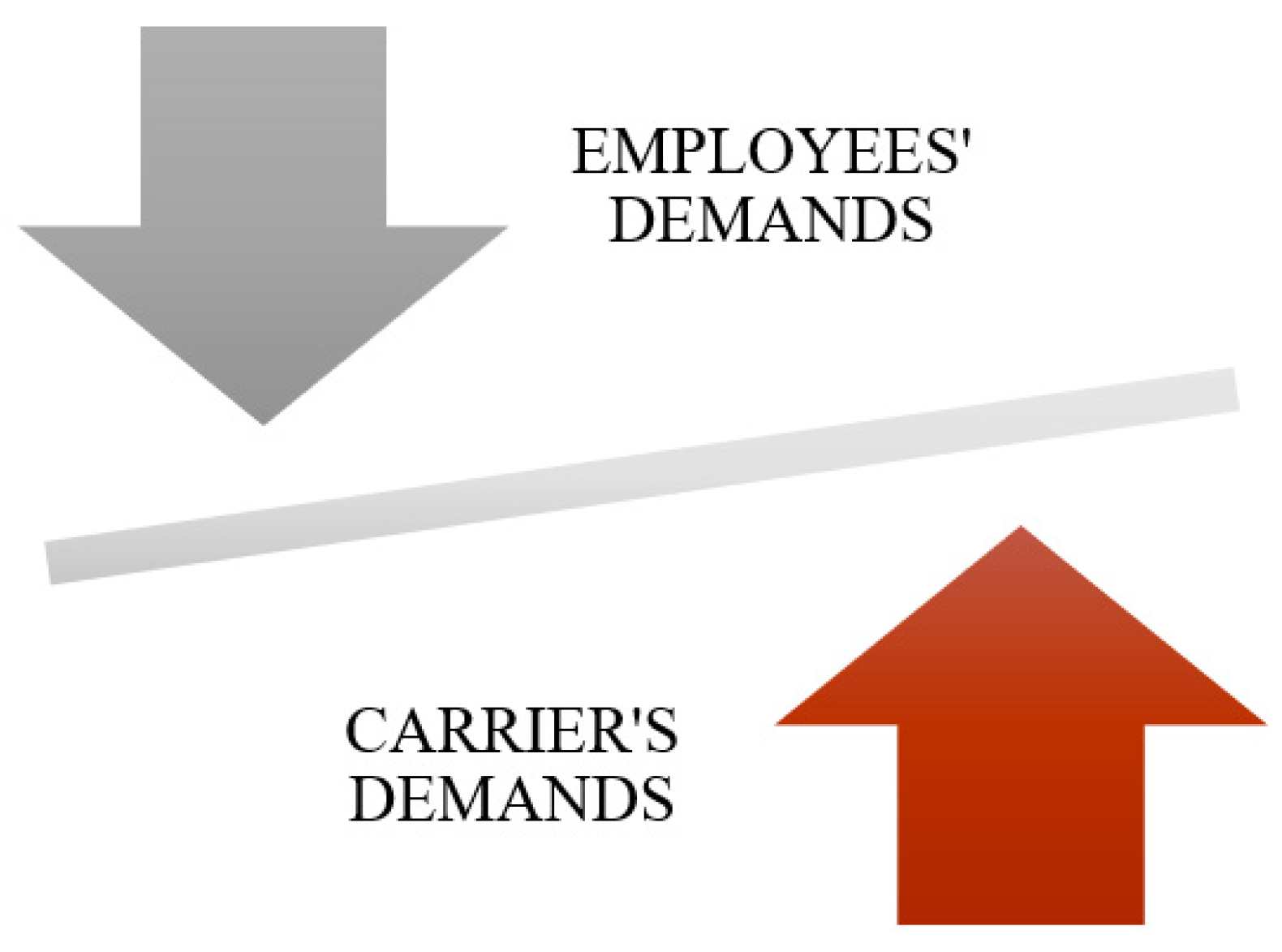
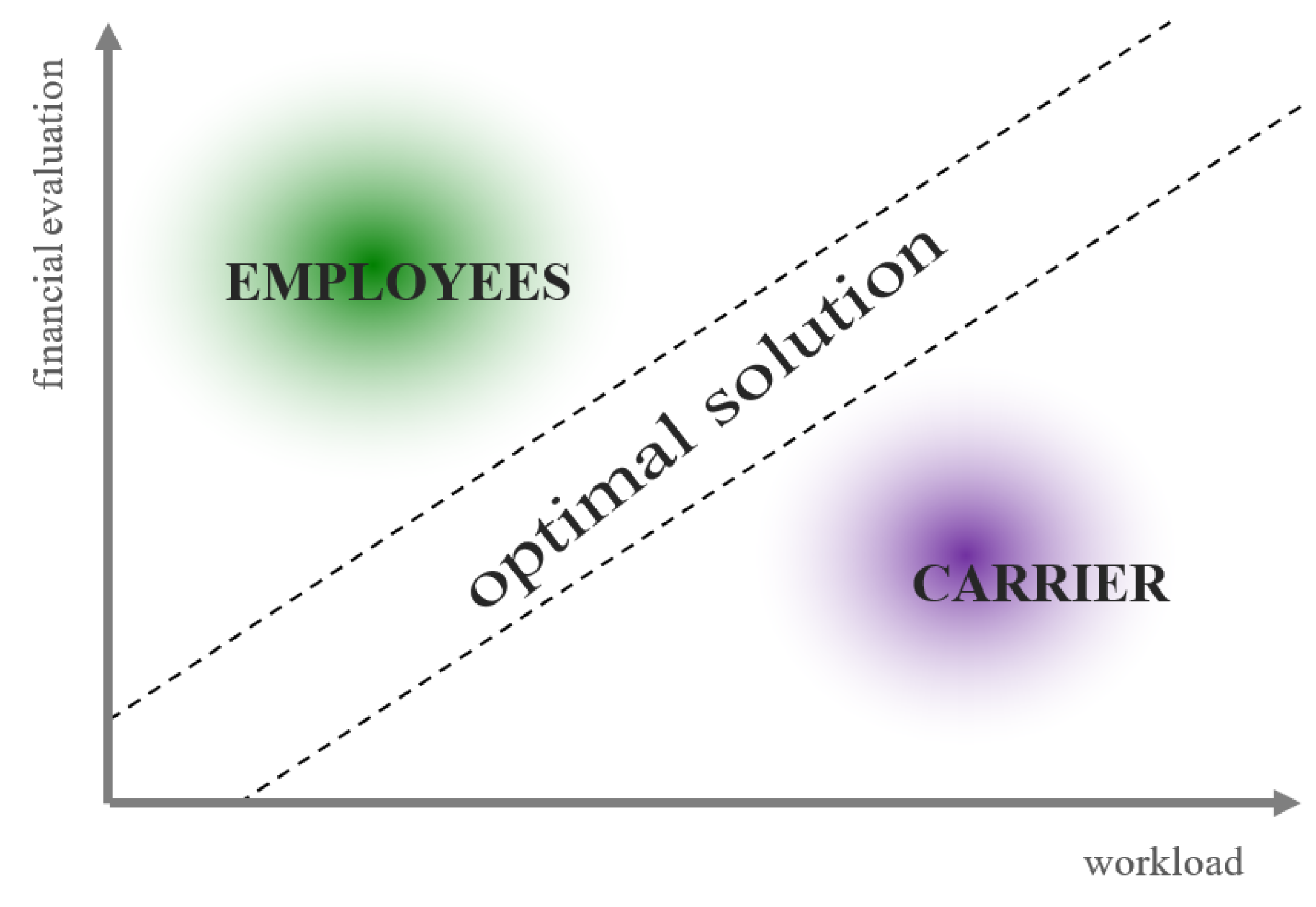
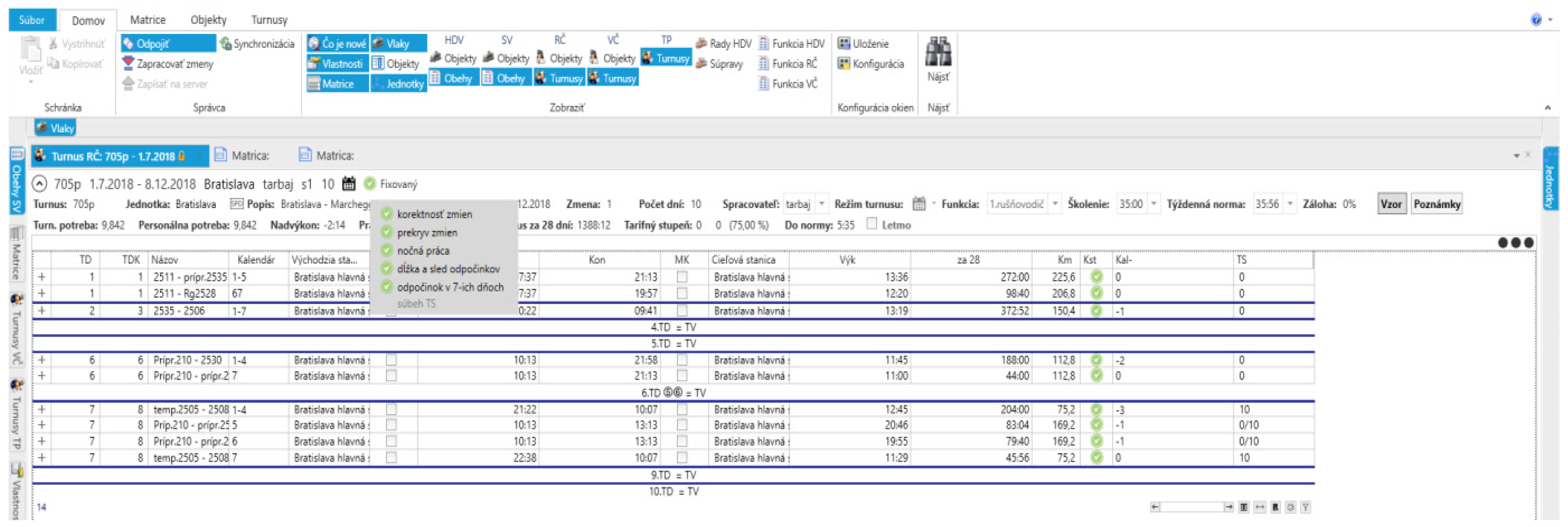

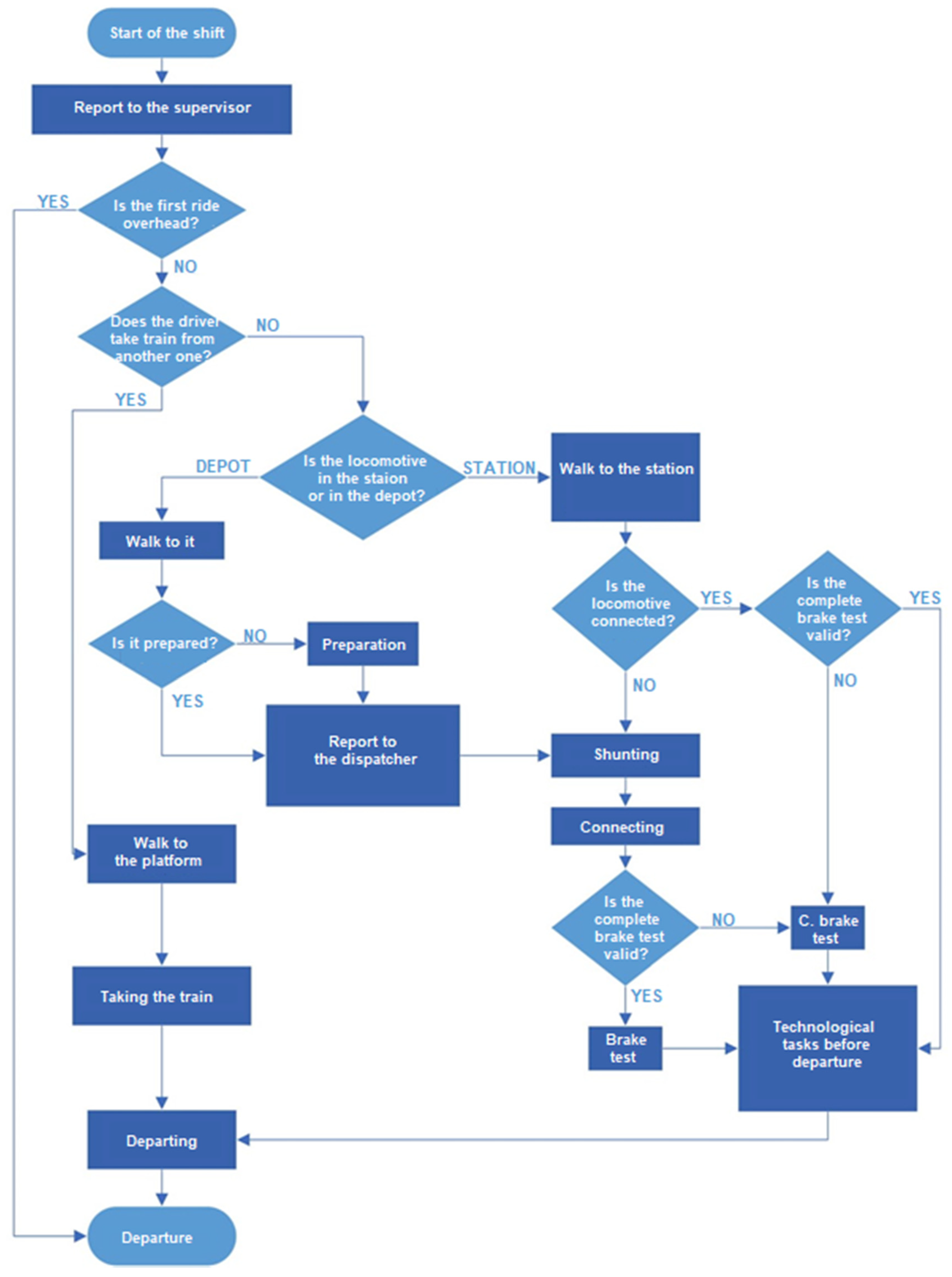
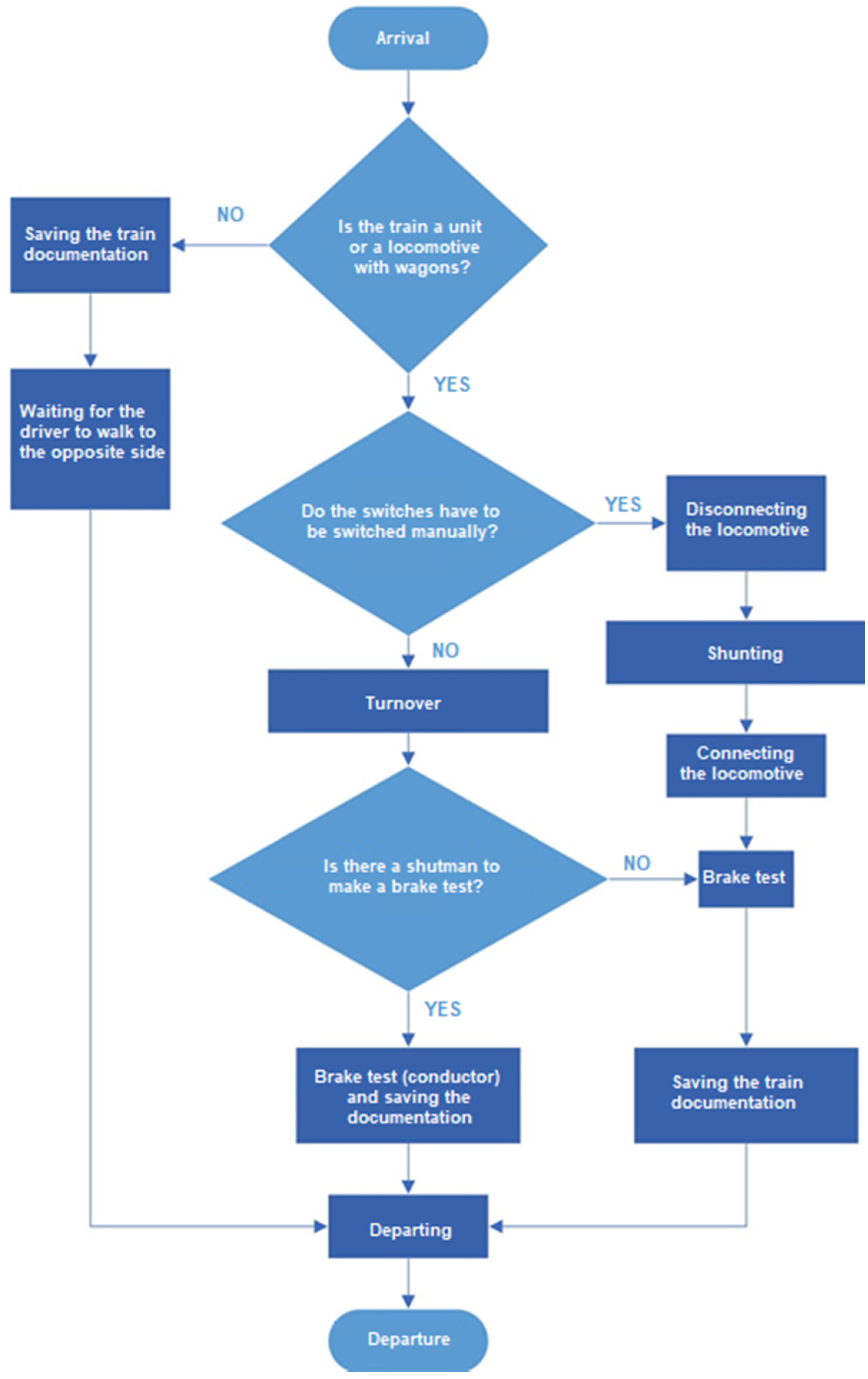
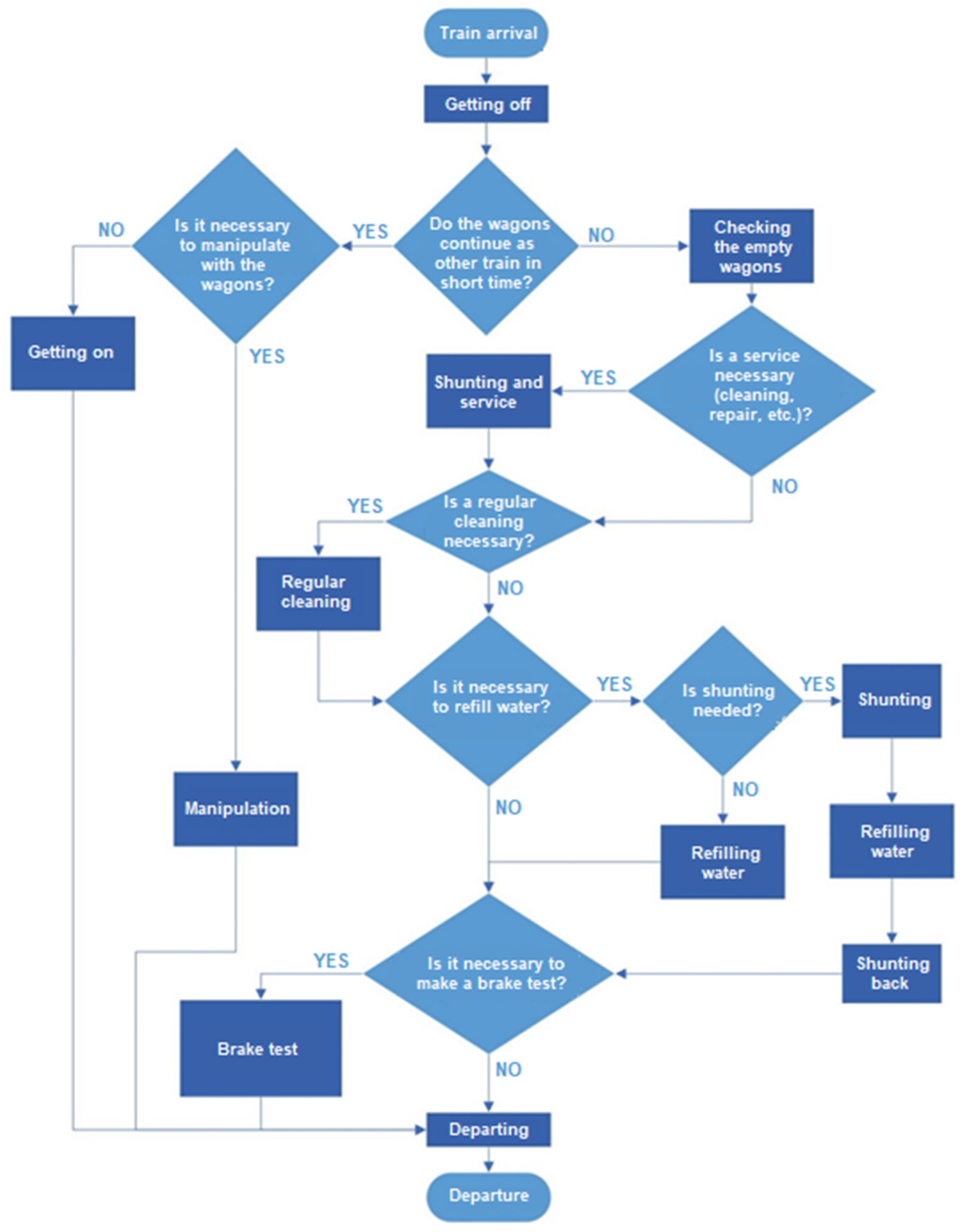
| Train Number | Departure | Arrival | ||
|---|---|---|---|---|
| 6400 | Košice | 4:58 | 5:38 | MnB mesto |
| 6401 | MnB mesto | 4:36 | 5:17 | Košice |
| 6402 | Košice | 6:35 | 7:23 | MnB mesto |
| 6403 | MnB mesto | 6:27 | 7:08 | Košice |
| 6404 | Košice | 10:11 | 10:54 | MnB mesto |
| 6405 | MnB mesto | 9:02 | 9:43 | Košice |
| 6406 | Košice | 14:11 | 14:54 | MnB mesto |
| 6407 | MnB mesto | 13:02 | 13:43 | Košice |
| 6408 | Košice | 16:11 | 16:51 | MnB mesto |
| 6409 | MnB mesto | 15:02 | 15:43 | Košice |
| 6410 | Košice | 18:25 | 19:05 | MnB mesto |
| 6411 | MnB mesto | 17:02 | 17:43 | Košice |
| 6412 | Košice | 22:25 | 23:05 | MnB mesto |
| 6413 | MnB mesto | 20:36 | 21:17 | Košice |
| 00 | 01 | 02 | 03 | 04 | 05 | 06 | 07 | 08 | 09 | 10 | 11 | 12 | 13 | |
|---|---|---|---|---|---|---|---|---|---|---|---|---|---|---|
| 00 | 1378 | 49 | 204 | 444 | 564 | 684 | 898 | |||||||
| 01 | 1421 | 78 | 294 | 534 | 654 | 788 | 998 | |||||||
| 02 | 1273 | 1384 | 999 | 339 | 459 | 579 | 793 | |||||||
| 03 | 1310 | 1407 | 183 | 423 | 543 | 677 | 917 | |||||||
| 04 | 1062 | 1173 | 1328 | 128 | 248 | 368 | 582 | |||||||
| 05 | 1155 | 1252 | 28 | 268 | 388 | 522 | 762 | |||||||
| 06 | 822 | 933 | 1088 | 1328 | 8 | 128 | 342 | |||||||
| 07 | 915 | 1012 | 1228 | 28 | 148 | 282 | 522 | |||||||
| 08 | 705 | 816 | 971 | 1211 | 1331 | 11 | 225 | |||||||
| 09 | 795 | 892 | 1108 | 1348 | 28 | 162 | 402 | |||||||
| 10 | 571 | 682 | 837 | 1077 | 1197 | 1317 | 91 | |||||||
| 11 | 675 | 772 | 988 | 1228 | 1348 | 42 | 282 | |||||||
| 12 | 331 | 442 | 597 | 837 | 957 | 1077 | 1291 | |||||||
| 13 | 461 | 558 | 774 | 1014 | 1134 | 995 | 68 |
| 00 | 01 | 02 | 03 | 04 | 05 | 06 | 07 | 08 | 09 | 10 | 11 | 12 | 13 | |
|---|---|---|---|---|---|---|---|---|---|---|---|---|---|---|
| 00 | 0 | 0 | 0 | 1 | 0 | 0 | 0 | 0 | 0 | 0 | 0 | 0 | 0 | 0 |
| 01 | 0 | 0 | 1 | 0 | 0 | 0 | 0 | 0 | 0 | 0 | 0 | 0 | 0 | 0 |
| 02 | 0 | 0 | 0 | 0 | 0 | 1 | 0 | 0 | 0 | 0 | 0 | 0 | 0 | 0 |
| 03 | 0 | 0 | 0 | 0 | 0 | 0 | 1 | 0 | 0 | 0 | 0 | 0 | 0 | 0 |
| 04 | 0 | 0 | 0 | 0 | 0 | 0 | 0 | 1 | 0 | 0 | 0 | 0 | 0 | 0 |
| 05 | 0 | 0 | 0 | 0 | 1 | 0 | 0 | 0 | 0 | 0 | 0 | 0 | 0 | 0 |
| 06 | 0 | 0 | 0 | 0 | 0 | 0 | 0 | 0 | 0 | 1 | 0 | 0 | 0 | 0 |
| 07 | 1 | 0 | 0 | 0 | 0 | 0 | 0 | 0 | 0 | 0 | 0 | 0 | 0 | 0 |
| 08 | 0 | 0 | 0 | 0 | 0 | 0 | 0 | 0 | 0 | 0 | 0 | 1 | 0 | 0 |
| 09 | 0 | 0 | 0 | 0 | 0 | 0 | 0 | 0 | 1 | 0 | 0 | 0 | 0 | 0 |
| 10 | 0 | 0 | 0 | 0 | 0 | 0 | 0 | 0 | 0 | 0 | 0 | 0 | 0 | 1 |
| 11 | 0 | 0 | 0 | 0 | 0 | 0 | 0 | 0 | 0 | 0 | 1 | 0 | 0 | 0 |
| 12 | 0 | 1 | 0 | 0 | 0 | 0 | 0 | 0 | 0 | 0 | 0 | 0 | 0 | 0 |
| 13 | 0 | 0 | 0 | 0 | 0 | 0 | 0 | 0 | 0 | 0 | 0 | 0 | 1 | 0 |
| Unit | Day | |
|---|---|---|
| 1 | 2 | |
| 1. unit | 00 → 03 → 06 → 09 → 08 → 11 → 10 → 13 → 12 → 01 | 01 → 02 → 05 → 04 → 07 → 00 |
| 2. unit | 01 → 02 → 05 → 04 → 07 → 00 | 00 → 03 → 06 → 09 → 08 → 11 → 10 → 13 → 12 → 01 |
Publisher’s Note: MDPI stays neutral with regard to jurisdictional claims in published maps and institutional affiliations. |
© 2020 by the authors. Licensee MDPI, Basel, Switzerland. This article is an open access article distributed under the terms and conditions of the Creative Commons Attribution (CC BY) license (http://creativecommons.org/licenses/by/4.0/).
Share and Cite
Čamaj, J.; Brumerčíková, E.; Hranický, M.P. Information System and Technology Optimization as a Tool for Ensuring the Competitiveness of a Railway Undertaking—Case Study. Sustainability 2020, 12, 8915. https://doi.org/10.3390/su12218915
Čamaj J, Brumerčíková E, Hranický MP. Information System and Technology Optimization as a Tool for Ensuring the Competitiveness of a Railway Undertaking—Case Study. Sustainability. 2020; 12(21):8915. https://doi.org/10.3390/su12218915
Chicago/Turabian StyleČamaj, Juraj, Eva Brumerčíková, and Michal Petr Hranický. 2020. "Information System and Technology Optimization as a Tool for Ensuring the Competitiveness of a Railway Undertaking—Case Study" Sustainability 12, no. 21: 8915. https://doi.org/10.3390/su12218915
APA StyleČamaj, J., Brumerčíková, E., & Hranický, M. P. (2020). Information System and Technology Optimization as a Tool for Ensuring the Competitiveness of a Railway Undertaking—Case Study. Sustainability, 12(21), 8915. https://doi.org/10.3390/su12218915





